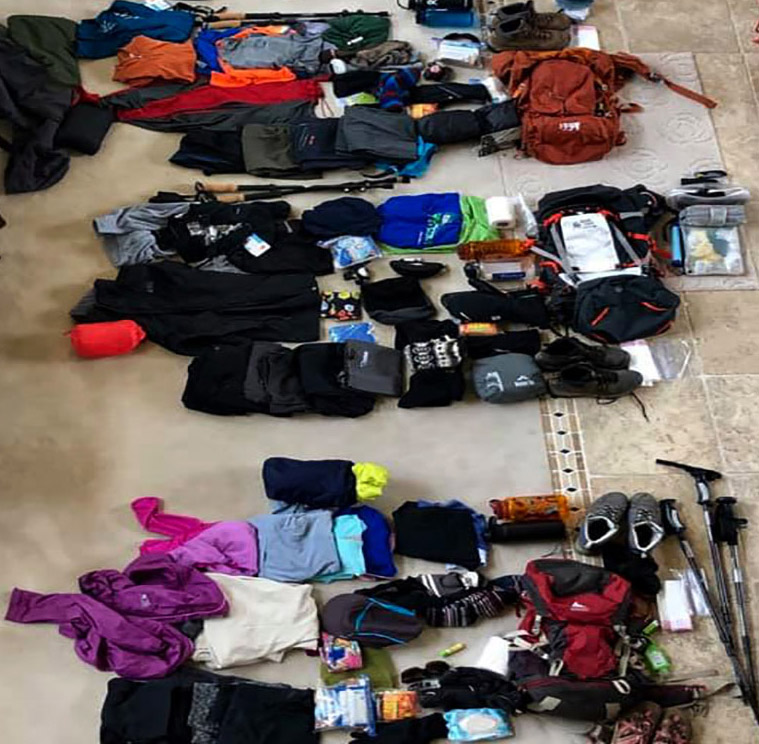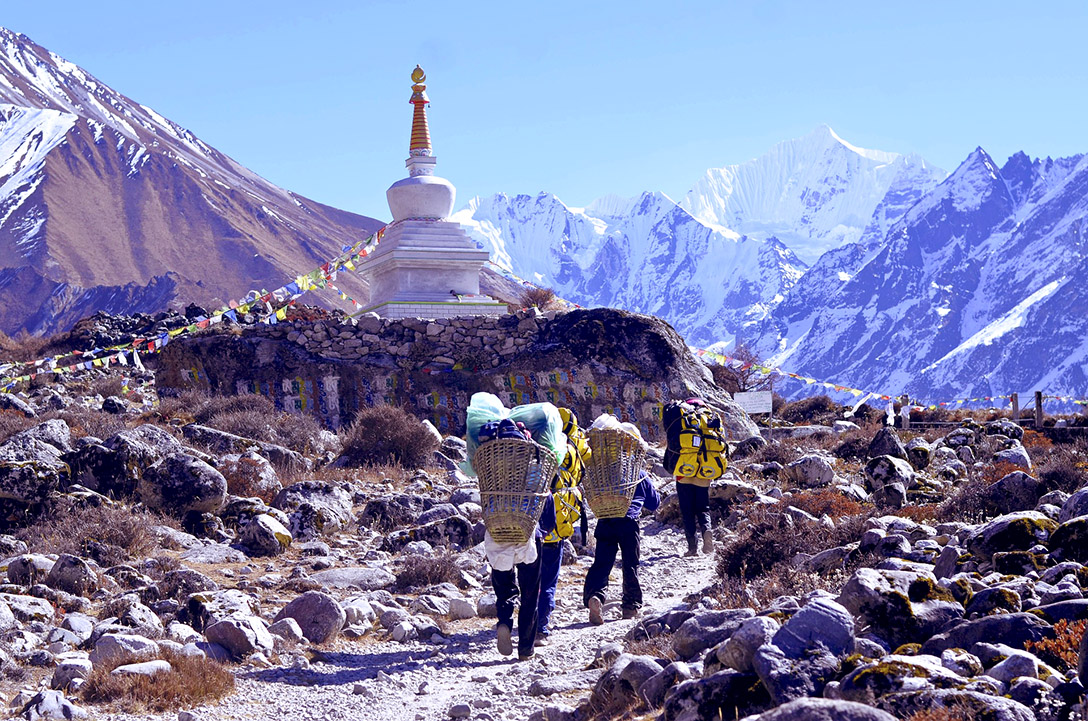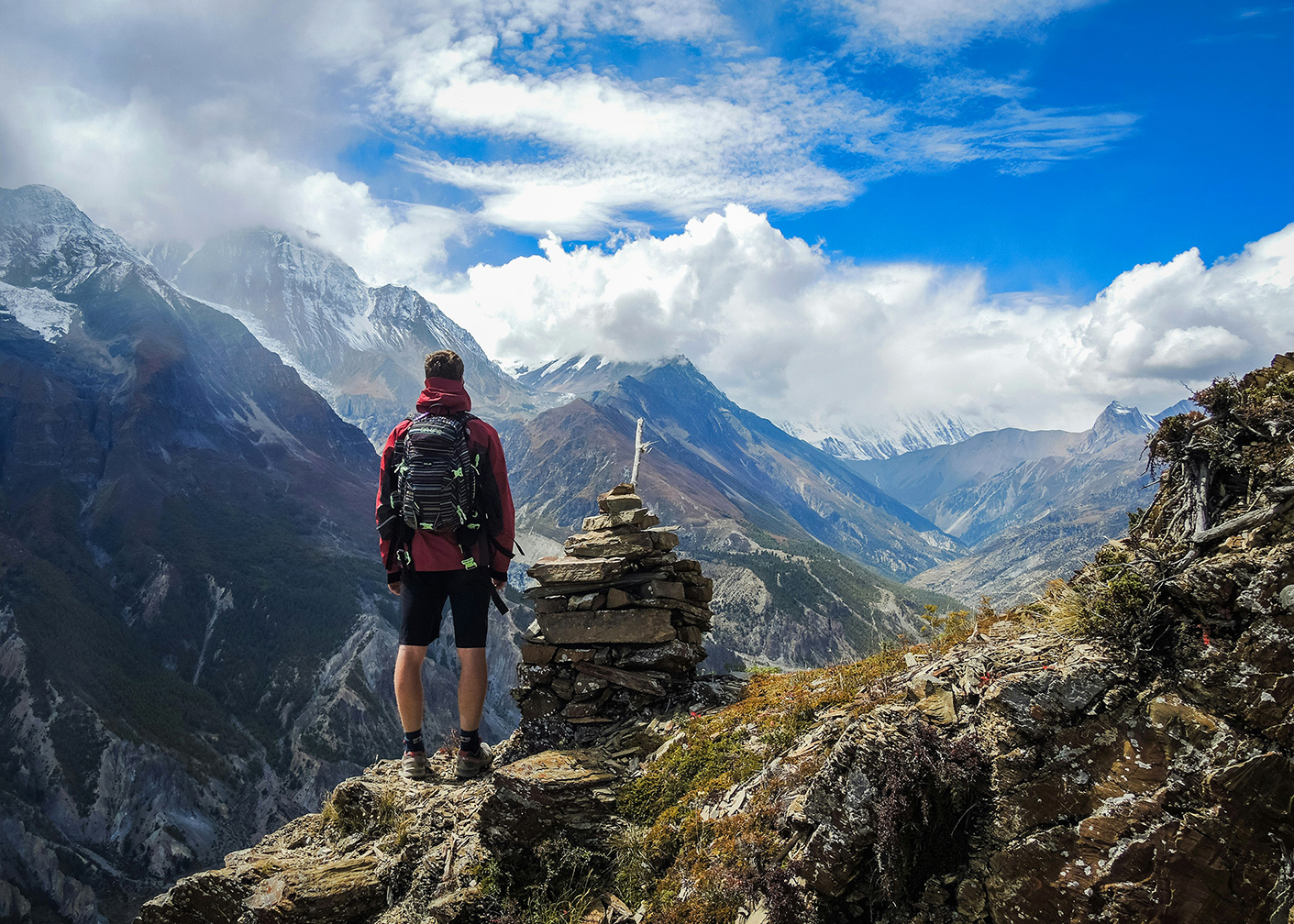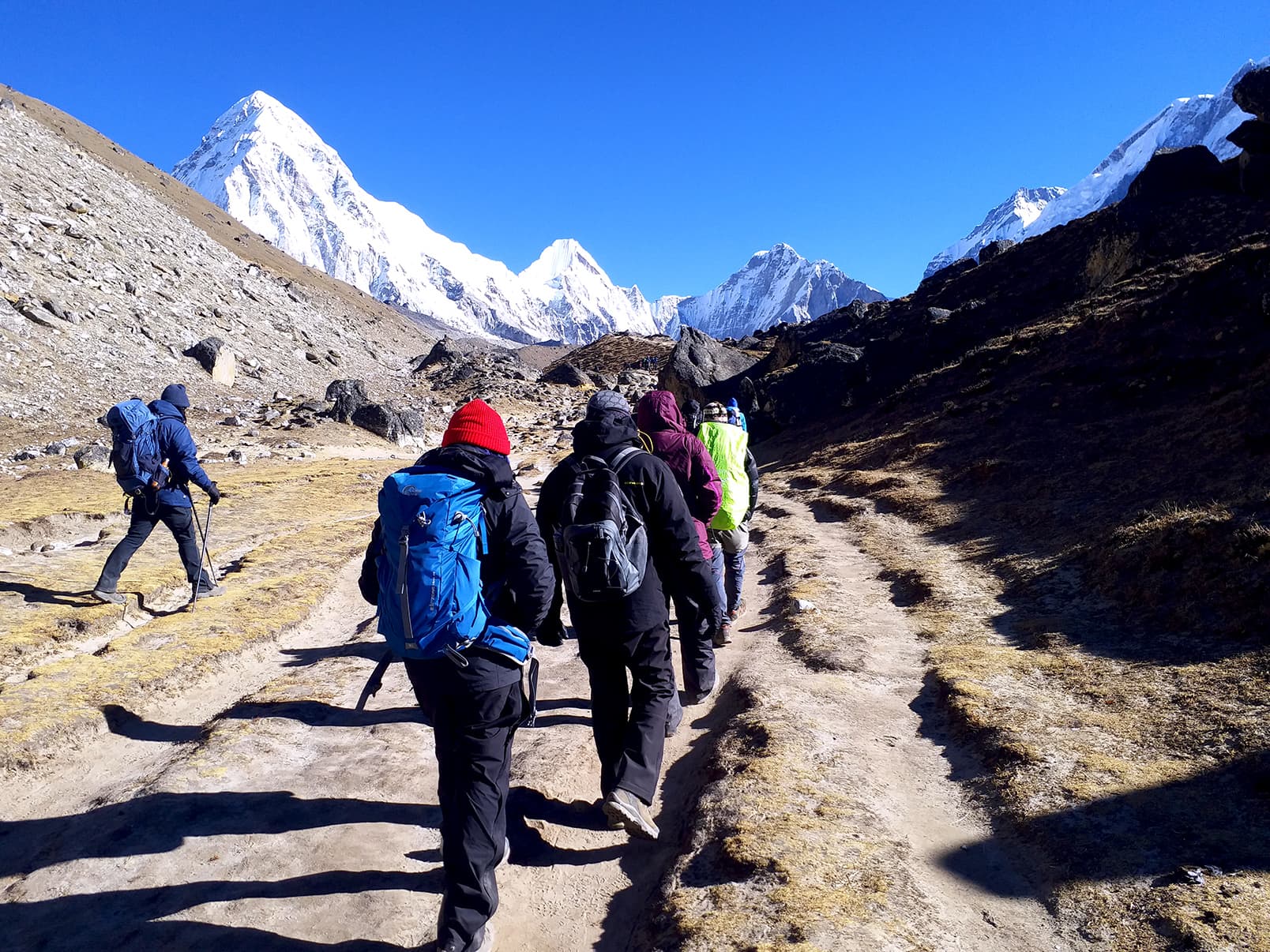The most thrilling trekking route that provides Himalayan experience in depth.
Preparing for a backpack travel in Himalayas is not an easy task; this includes many days of preparation and long hour of organized packing your utilities. Travelers will have to prepare 2 separate bags, the first backpack commonly called a daypack with delicate belongings to be carried by themselves and the second with all necessary utilities for the entire trip to be carried by the strong local porters of the trip. You can either bring everything(equipment) from your home or you can rent/buy any gear required for the trekking in Nepal. Backpack travel essentials for Himalayan treks in Nepal can mainly be organized in general as below.
Tools required to keep travelers comfortable during their Backpack Travel in Himalayas are listed below in detailed categorical basis for our valued readers.
1) For daypack to be carried by travelers during backpack travel in Himalayas:
1(a) Important Documents and Items
- Valid passport, 2 extra passport size photos, airline tickets
- Separate photocopies of passport, visa form (easily obtained at Kathmandu airport), proof of insurance
- Some cash for purchasing a Nepalese visa at Kathmandu airport, bills restaurants and hotels, for gratuities, snacks, and to purchase your drinks and gifts.
- Credit cards, Bank/ATM/Cash machine cards for withdrawing funds from cash machines traveler’s checks, etc.
- Electronic gadgets
1(b) Personal Medical Utilities
- Small, personal first-aid kit. (simple and light)
- Aspirin, first-aid tape, and plasters (Band-Aids)
- 1 skin-blister repair kit
- Anti-diarrhea pills
- Anti-headache pills
- Cough and/or cold medicine
- Anti-altitude sickness pills: Diamox or Acetylzolamide
- Stomach antibiotic: Ciprofloxacin, etc. Do not bring sleeping pills as they are a respiratory depressant.
- Water purification tablets or the water filter
- 1 set of earplugs
- Extra pair of prescription glasses, contact lens supplies, and other necessary medicine if any
1(c) Practical Items and Utilities
- 1 small roll of repair tape, 1 sewing-repair kit
- 1 cigarette lighter, 1 small box of matches
- 1 compass or GPS(optional)
- 1 alarm clock/watch
- Large Ziplocs
- 2 water bottles (1 liter each)
- 1 small folding knife
- Binoculars (optional)
- 4 large, waterproof, disposable rubbish sacks
1(d) Toiletries Utilities
- 1 medium-sized quick-drying towel
- Toothbrush/paste (preferably biodegradable)
- Multi-purpose soap (preferably biodegradable)
- Deodorants
- Nail clippers
- Face and body moisturizer
- Female hygiene products
- Small mirror
- Personal Hygiene
- Wet wipes (baby wipes)
- Tissue /toilet roll
- Anti-bacterial hand wash and sanitizers

2) For the backpacks to be carried by assisting staffs during trips
2(a) Rucksack and Travel Bags
- 1 medium rucksack (50-70 liters/3000-4500 cubic inches, can be used for an airplane carryon)
- 1 large duffel bag *
- A small daypack/backpack for carrying your valuables should have good shoulder padding
- Small padlocks for duffel-kit bags
- 2 large waterproof rucksack covers (optional)
2(b) Utilities for Head
- Bandana or head scarf, also useful for dusty conditions
- Warm hat that covers your ears (wool or synthetic)
- Headlamp with extra batteries and bulbs
- Sunglasses with UV protection
- Prescription sunglasses (if required)
2(c) Utilities for Upper Body
- Polypropylene shirts (2 half sleeves and 2 long sleeves)
- Light and expedition-weight thermal tops
- Fleece wind-stopper jacket or pullover
- Waterproof (preferably breathable fabric) shell jacket
- Down vest and/or jacket *
- Gore-Tex jacket with hood, waterproof and breathable
- Utilities for Hands
- 1 pair of lightweight poly-liner gloves
- 1 pair of lightweight wool or fleece gloves
- 1 pair of mittens; consists of 1 Gore-Tex over mitt matched, waterproof, polar-fleece mitt liner
2(d) Lower Body
- Non-cotton underwear briefs
- 1 pair of hiking shorts
- 1 pair of hiking trousers
- 1 pair of lightweight thermal bottoms
- 1 pair of fleece or woolen trousers
- 1 pair of waterproof shell pants, breathable fabric
2(e) Utilities for Feet
- 2 pairs of thin, lightweight inner socks
- 2 pairs of heavy poly or wool socks
- 1 pair of hiking boots with spare laces (sturdy soles, water resistant, ankle support, “broken in”)
- 1 pair of trainers or running shoes and/or sandals
- Cotton socks (optional)
- Gaiters (winter only), optional, “low” ankle high version)
2(f) Sleeping Utilities
- 1 sleeping bag (good to -10 degrees C or 14 degrees F)*
- Fleece sleeping bag liner (optional)
2(g) Extras/Luxury Utilities
- Reading book
- Trail map/guidebook
- Journal and pen
- Travel games i.e. chess, backgammon, scrabble, playing cards (to help you pass the time at teahouses and/or camps)
- 1 modest swimsuit
- Binoculars (optional)
- Voltage converter (from 220 to 110)
- Plug adapter (2 round pegs to 2 flat pegs)
- Lightweight pillow case (in case your teahouses provide you with pillows) or use your stuff as a pillow
A Short Real Story on Nepal’s Backpacking Background:
The native people of Nepal till about 100 years ago had no access to highways and even simple roadways. The only possible travel option at that time to get around the different locations of the country was with the use of their legs. People had to carry the necessary food supplies and sleeping equipment required every day along with them since there were no hotel facilities available. The backpack was the only miracle of that time on which their survival, transfer and delivery relied. The backpack of that time used to carry daily supplies for multiday trips, travelers’ personal belongings and the goods which they are about to transfer from one place to another. The successful backpack travel journey involved essential loads carefully selected not to overload the traveler or carrier, properly arranged packing of that loads so that is convenient to unpack and repack every day after use with the perfect technique to carry that backpack for the entire trip. Similarly, the backpack travel practice became useful with the army troops as they had to carry ammunition and other essential supplies with them never knowing for how long the war might last. People of this Himalayan country are used to backpacking travel practices and how to make the most out of this type of travel style.

The Now of Nepal’s Backpacking Travel at 2024 AD
In the present context, backpack travel has been a style to travel or flexibility to go around the world. When we consider comfortable landscapes like cities and well-settled villages around any corner of the world backpacking is a cheaper version of exploring it. You can pack anything that you think might be required, set the route, get vehicles for transfer, places to stay and eat during normal backpacking trips. But the story is different in Nepal, which stayed a remote and secular Kingdom till a few years back and recently announced that only guided trips are allowed on its Himalayan trekking trails. Himalayas has different variations and demands of the backpack from any travelers who wish to explore its landscapes. Leaving few touristic cities and villages, we must adopt doing backpack travel in Nepal. However, there are strong and happy porters in case travelers do not want to carry their daypacks either. The backpacks for tours, trekking, and climbing in this Himalayan destination require a different set of goods we pack inside the backpack. The city/village tours can be done even without the backpack but the multiday treks and expeditions are impossible without at least 1 backpack per person. As mentioned the materials we pack for each travel style in such Himalayan journeys are different depending on what you are about to accomplish.

Even by paying the amount for luxury treks or expeditions in the Himalayan trips, one has to carry a backpack but it is to enhance the traveler’s efficiency in ascending the Himalayan trails. Scientifically it has been proved (https://www.tandfonline.com/doi/full/10.1080/17461391.2021.1953154) that carrying a calculated load on your back with the support of both shoulders while climbing uphill makes it easy to advance onward. For this reason, trekkers are advised to carry a weight-limited daypack while on the trekking trip of the Himalayas. This is how the backpack becomes an inevitable thing to carry during any Himalayan trip as a part of your journey. For a long time, trekkers have been appreciating the daypack they carried as their backpacks. Those backpack trekkers carry contains their vital utilities like passports, electronic gadgets, wallets, medicines, water, instant snacks, etc. Carrying those things with the travelers themselves made it convenient for them to get their hands on what they might need right here right now. The main backpack of trekkers carried by porters in the Himalayan treks contains all their daily utilities and belongings. The porters carrying the main backpack may not necessarily walk with trekkers all day long because they are carrying heavy loads and have to leave the hotel before travelers and reach the next stop before trekkers. Hence backpack travel in Himalayan trips like trekking cannot be considered an option.
The above utility normally goes into multiday adventure treks in the Himalayas. Depending on the activities you might be doing during the trip, materials and utilities can be different. The requirements of simple city tours to adventure trips of the Himalayas are different. Except for the daypack you would carry, other big backpacks will be carried by porters, mules, or even by guides sometimes based on what places you are traveling in and which services level you have selected to go with. There is plenty of option to organize and carry those backpacks. We will consult in-depth being personal with every traveler during the time of trip preparation. The responsibility to make every trip convenient and satisfying is always ours at Himalayan Adventure Therapy.




